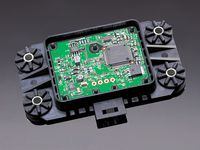Engine technology has largely been focused on the electronics lately. Building high-strung motors that would be impossible to ride without a computer in the loop has underpinned the current horsepower competition. But there’s only so much careful manipulation of throttle and ignition can do.
The next great frontier is valve timing, which Ducati has tackled with DVT—Desmodromic Variable Timing—found on the new Multistrada. By individually changing the phasing of the camshafts relative to the crankshaft, Ducati's technology enables an engine tuned for smooth low-rpm running and, potentially, with a torque boost that also screams at the top of the rev range. Until now, the two were almost mutually exclusive.
A technology commonplace in cars today, variable valve timing has been used before on Kawasaki’s Concours 14 but only for the intake valves and with limited range. Ducati’s system works on both the intakes and exhausts and can change the overlap interval from a negative 37 degrees to 53 degrees. Ducati’s previous high-performance Testastretta had 41 degrees of overlap, while the follow-on versions found in the Multi had just 11 degrees, benefitting low-rpm power. Now the new Multi has both the potential for big numbers at the top of the range and refinement down below. It’s just a matter of time before this technology permeates Ducati’s lineup and infiltrates other manufacturers too.
ALTERNATIVE TAKE // IMU
It's been suggested that the smartphone in your pocket has more computing power than all the Apollo missions combined. Miniaturization and mass production have made solid-state sensors commonplace, including on our motorcycles. The Inertial Measurement Unit is, quite simply, a box that tells the bike's brain what the bike's body is doing, which makes traction control, ABS, and adaptive suspension simply work better.


/cloudfront-us-east-1.images.arcpublishing.com/octane/IN263JIBTBCD3O265IMSCW6OZM.jpg)
/cloudfront-us-east-1.images.arcpublishing.com/octane/SMAQ354X2JH7NJATXNSQY4NRS4.jpg)
/cloudfront-us-east-1.images.arcpublishing.com/octane/GGOH2AQRSVHY5C5JLNEVYLB5SU.jpg)
/cloudfront-us-east-1.images.arcpublishing.com/octane/TJJEHV3ATZFFXHUYZABHXKE2DI.jpg)
/cloudfront-us-east-1.images.arcpublishing.com/octane/WIC4RXQ36BAXNIW6U4UJ3XDLKI.jpg)
/cloudfront-us-east-1.images.arcpublishing.com/octane/B4PQZLY4LBHITGE5ZRRM2N5YNU.jpg)
/cloudfront-us-east-1.images.arcpublishing.com/octane/OBYS7KWZUJFCHD44YPTSVM5EF4.jpg)
/cloudfront-us-east-1.images.arcpublishing.com/octane/FY7ZXYBT4NH2NGYQIWQVITS4AM.jpg)
/cloudfront-us-east-1.images.arcpublishing.com/octane/JPET6WQUDZEYLNXVY5LRNDRPLA.jpg)
/cloudfront-us-east-1.images.arcpublishing.com/octane/EY6P2QIFQJCDTNOMR3JB7WJED4.jpg)
/cloudfront-us-east-1.images.arcpublishing.com/octane/V2U6JB7KXNCQRN4OW6HNJTVMZQ.jpg)
/cloudfront-us-east-1.images.arcpublishing.com/octane/AMS43BT5ABH77NY7XKLCSZCNM4.jpg)
/cloudfront-us-east-1.images.arcpublishing.com/octane/NTK2ASYKUBDW5MQDWQLVQYOELY.jpg)
/cloudfront-us-east-1.images.arcpublishing.com/octane/SX7R3KCIANGDBGF45O73F543TM.jpg)
/cloudfront-us-east-1.images.arcpublishing.com/octane/ZTW4V7RAPFG6RFWJRXR2IX5ZQ4.jpg)
/cloudfront-us-east-1.images.arcpublishing.com/octane/EPRSLPIUTBC5RPD7R263BPV2D4.jpg)
/cloudfront-us-east-1.images.arcpublishing.com/octane/EMJ4I2T4HVCRVJPZ3UJFVMRDHA.jpg)
/cloudfront-us-east-1.images.arcpublishing.com/octane/CBDAM3VMJNFDBLE7Y3FY7RD5BY.jpg)
/cloudfront-us-east-1.images.arcpublishing.com/octane/CCEB3TNMU5FH3OZ4FKJ7DA2LBA.jpg)
/cloudfront-us-east-1.images.arcpublishing.com/octane/VV6N3KUWEVFJJD7F7VX6ICOH7Q.jpg)
/cloudfront-us-east-1.images.arcpublishing.com/octane/R55SVEXZ5VA2LCWFWYR647ASX4.jpg)
/cloudfront-us-east-1.images.arcpublishing.com/octane/MYWIEFOQ6JCCNDR4OBF5PU5LVE.jpg)
/cloudfront-us-east-1.images.arcpublishing.com/octane/OOZ3C4GCUJGRNONDI6DHVM57GI.jpg)
/cloudfront-us-east-1.images.arcpublishing.com/octane/JEKB3CMWXZD6ZAVFEDKLOQ5FNY.jpg)